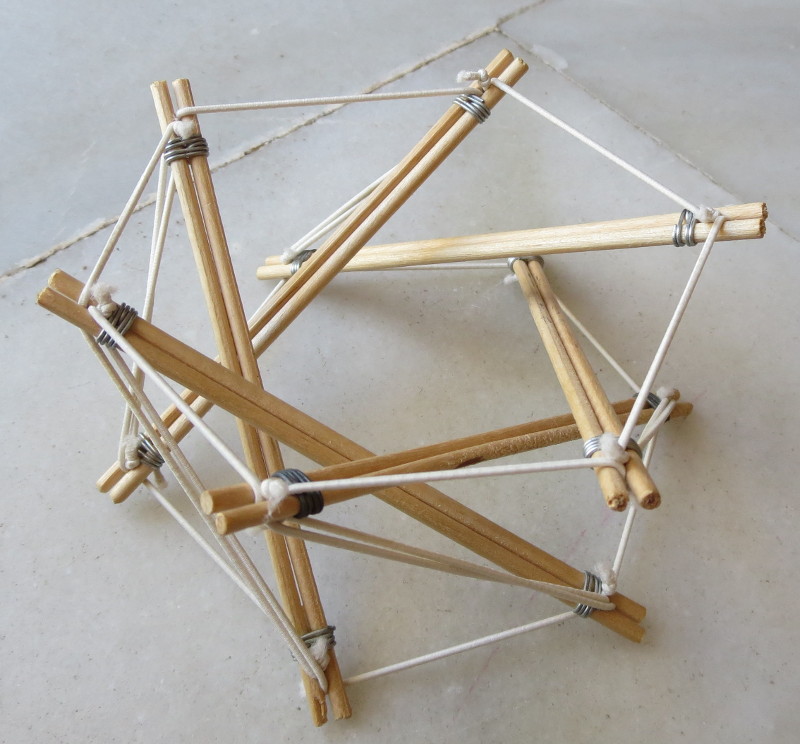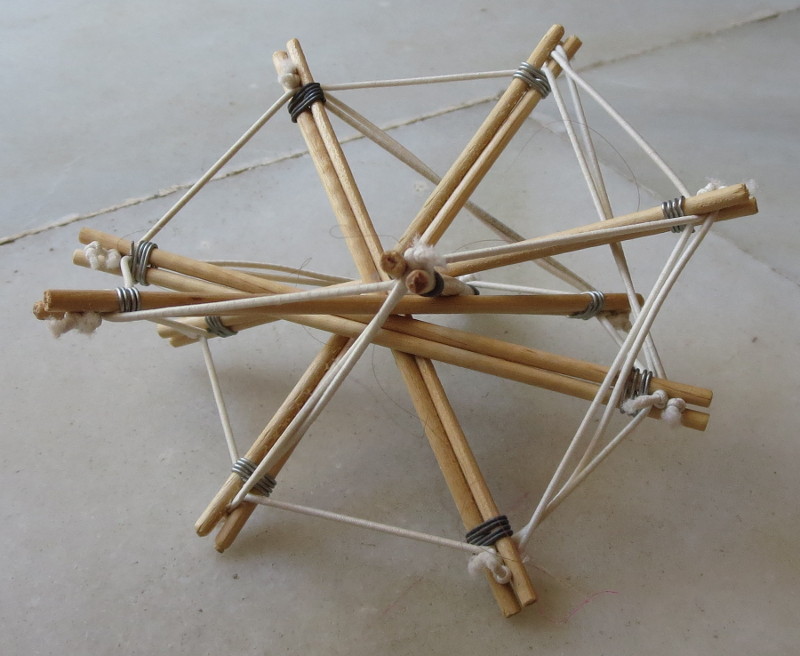Prism
Read here about the prism, a primitive form significant to both standard polyhedral geometry and tensegrity morphology.
Definition
In vernacular English, a prism refers to a transparent optical element with triangulated, flat, polished surfaces that refract light. The optical prism borrows the noun, prism, from its older geometric meaning. Euclid, applying the Late Latin term prisma, from Greek prisma literally "something sawed," labeled as a prism a volume that seems to have some of its surfaces "sawn off."
The geometrical definition of 'prism' invokes concepts of polyhedra and symmetry. A prism an n-sided prism is a polyhedron made of an n-sided polygonal base, a translated copy, and n faces joining corresponding sides. Thus these joining faces are parallelograms. All cross-sections parallel to the base faces are the same. A prism is a subclass of the prismatoids.
The prismatic joint is also important to research into tensegrity structures and particularly tensegrity robotics. A prismatic joint provides a linear sliding movement between two bodies, and is often called a slider, as in the slider-crank linkage. The relative position of two bodies connected by a prismatic joint is defined by the amount of linear slide of one relative to the other one. This one parameter movement identifies this joint as a one degree of freedom kinematic pair. Prismatic joints provide single-axis sliding often found in hydraulic jacks and telescopic constructions.
General, right and uniform prisms
A right prism is a prism in which the joining edges and faces are perpendicular to the base faces. This applies if the joining faces are rectangular. If the joining edges and faces are not perpendicular to the base faces, it is called an oblique prism. Some texts may apply the term rectangular prism or square prism to both a right rectangular-sided prism and a right square-sided prism. The term uniform prism can be used for a right prism with square sides, since such prisms are in the set of uniform polyhedra.
Right prisms with regular bases and equal edge lengths form one of the two infinite series of semiregular polyhedra, the other series being the antiprisms. A right rectangular prism is also called a cuboid, or informally a rectangular box. A right square prism is simply a square box, and may also be called a square cuboid. The dual of a right prism is a bipyramid.
A parallelepiped is a prism of which the base is a parallelogram, or equivalently a polyhedron with 6 faces which are all parallelograms.
An equilateral square prism is simply a cube.
An n-prism, having regular polygon ends and rectangular sides, approaches a cylindrical solid as n approaches infinity.
Topology Family
Whittier defines the T-Prism as a primary topology of tensegrity structures. He wrote,
There is a family of tensegrity structures, the basic structure of which consists of two equal end polygons in parallel planes joined by members at their vertices [Stern and Duffy 2001]... with triangles as the end polygons. This family will be called the prism family. The end polygons are not required to remain of equal size or in parallel planes and may even become skew, but they must be geometrically similar. Stern and Duffy show that original configurations that are tensegrity positions can easily be found for these structures. Starting in a configuration with the end polygons lined up such that the sides are parallel, the top polygon is rotated by a twist angle a with respect to the base polygon. The angle a can be found from the equation, α = π / 2 - π / n, where n is the number of sides in the end polygons. [3]
Unit Tensegrity Prism
Emmerich enumerated in his examination of "self-stressed planar nets" many configurations based on prismatic, anti-prismatic, anti-pyramidal, interlaced and inter-penetrated tensegrity modules creating several and variable tessellations. [2]
Below are many significant aspects of prisms in tensegrity research.
The 3 strut simplest prism
The three-strut tensegrity is often claimed to be the simplest, most primitive tensegrity; it forms a prism.Zhang, Guest, and Ohsaki in their presentation "Symmetric Prismatic Tensegrity Structures" present this progression of prisms from 3 strut to 4, 5, and 9 strut prisms:
They label the components and differentiate between the prism's types of stability.
Tensegrity Twist in Prisms
In tensegrity prisms or pyramids, there is always a twist angle (a) between both bases, depending on the number of sides or struts of the system (n), following the formula a = 90º - 180º / n. [2]
For more information, see Twist Angle.
Winding Direction
The direction of tendon winding is significant. Winding in the wrong direction can cause the prism to collapse.
Deployable, Foldable Prisms
The tensegrity prism can be made deployable, if the base and cap allow the struts to fold together.
Analysis using affine transformations
Schenk wrote: "By combining the analytical solutions for the regular tensegrity prisms with the knowledge of affine transformations, we can describe and understand the skew tensegrity prisms much better. Under a pure skew transformation, preserving parallel planes, the twist angle must remain constant. This verifies the observation of Burkhardt (2006). Furthermore, the analytical equilibrium solutions for the regular tensegrity prisms can be applied to any skewed version, including where the top and bottom polygon are no longer equilateral." [1]
Assembling a Sphere from Prisms
Tensegrity prisms can be aggregated into a spherical array, resulting in a large spherical construction.
92 Prism Tensegrity
The 92 prism tensegrity is formed of 92 prisms joined in a deresonated tensegrity structure. See 92 Prism Tensegrity.
Links and References
[1] DRAFT: Analysis of Skew Tensegrity Prisms, Mark Schenk, March 6, 2006
[2] New configurations for double-layer tensegrity grids, by Gómez-Jáuregui, Otero, Arias, Manchado
[3] Kinematic Analysis of Tensegrity Structures By William Brooks Whittier Thesis submitted to the Faculty of the Virginia Polytechnic Institute and State University 2002. Link








